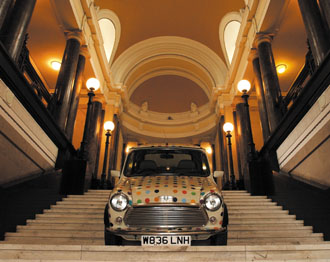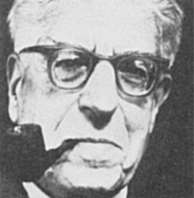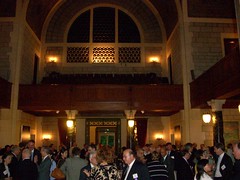This article is about the Jeopardy!
champion. For other people with the same name, see Ken Jennings (disambiguation). Kenneth Wayne Jennings III (born
May 23,
1974) holds the record for the longest winning streak on the
U.S. syndicated game show Jeopardy! Jennings won 74 games before he was defeated by challenger Nancy Zerg on his 75th appearance. His total earnings on
Jeopardy! are
US$3,022,700 ($2,520,700 in winnings, a $2,000 consolation prize on his 75th appearance, and $500,000 in the
Jeopardy! Ultimate Tournament of Champions). Jennings held the record for most winnings on any game show ever played until the end of the Ultimate Tournament of Champions (first aired on
May 25,
2005), when he was displaced by
Brad Rutter, who defeated Jennings in that tournament.
After winning, he began working on a book,
Brainiac: Adventures in the Curious, Competitive, Compulsive World of Trivia Buffs, which explored American
trivia history and culture. Ken also appeared as a member of the mob sitting in podium #13 from the new game show
1 vs. 100 in 2006, and in 2007 Jennings was the champion of the first season of the US version of
Grand Slam.
Biography Before 2003,
Jeopardy! contestants were limited to five consecutive games. At the beginning of the show's twentieth season (in 2003), the rules were changed to allow contestants to remain on the show as long as they continued to win.
On
December 1,
2004, the show broke with tradition by having Jennings make a "guest appearance" at the start of the broadcast, during which host
Alex Trebek acknowledged his success and enumerated the various game show records he had broken.
Streak on Jeopardy! According to the Nielsen TV National People Meter,
Jeopardy!'s ratings were 22% higher during Jennings's run than they were during the same period the previous year. For several weeks of the winnings streak, Jeopardy! was ranked as TV's highest-rated syndicated program.
Ratings impact Jennings has received a good deal of American media coverage. After his 31st win on
Jeopardy!, during the summer break between tapings, Jennings made a guest appearance on
Live with Regis and Kelly. There Jennings revealed that he had failed to qualify for
Who Wants to Be a Millionaire, once hosted by
Regis Philbin. During that guest appearance, Jennings said, "
Jeopardy! is a man's game... it's not like
Millionaire."
Jennings appeared on
The Late Show with David Letterman to present
Letterman's "Top Ten List." He appeared again on the program on the night his final show was televised, in addition to interview segments airing that night on local 11 p.m. news programming and on
Nightline.
Barbara Walters selected Jennings as one of the "Ten Most Fascinating People of 2004" for her twelfth annual
ABC News special, which aired on
December 8,
2004. While on his media tour following his final game, Jennings taped a segment for a future episode of
Sesame Street.
TV Guide featured a segment of "The Top Ten TV Moments of 2004", in which Ken Jennings' loss placed third.
A&E aired on
December 1,
2004 an episode of the
Biography television program on Jennings and other
Jeopardy! notables, including
Frank Spangenberg and
Eddie Timanus.
He also appeared twice on
NPR's
Wait, Wait, Don't Tell Me program.
In 2006, Jennings was a celebrity member of the Mob on
1 vs. 100, beginning with its
October 13 premiere. He was eliminated on
October 20 when he missed a question about roulette, leaving with winnings of $741.29 (part of a $35,000 prize shared among 49 Mob members). He made another appearance on
February 9,
2007 on a special episode that brought back a number of notable mob members for a winner-take-all showdown; there, he was eliminated from the final five on a question about which celebrity had had the most marriages. If he had won this tournament, his $100,000 prize for winning
Grand Slam would have returned Ken to first place in the game show winnings world.
Jennings is the champion of the 2007 US version of
Grand Slam, a single elimination tournament among top quiz show contestants.
 Other media appearances
Other media appearances When asked what he intended to do with his winnings, Jennings said that he intends to
tithe ten percent to his church, donate to
public television and
National Public Radio, go on a trip to Europe, and invest the rest for his family. Jennings also appeared in a special "Last Man Standing" episode of the show on
February 9,
2007. He was eliminated on the final question, where he was asked who of a selection of three people were married the most times. He answered
King Henry VIII, while the correct answer was
Larry King. This episode was the first time Jennings had a chance at a rematch against rival
Brad Rutter. After waiting three years, Jennings finally beat Rutter by making it to the final 5, whereas Rutter only lasted to top 25.
In Summer 2007 Jennings appeared as a contestant on the game show
Grand Slam hosted by
Dennis Miller and
Amanda Byram. The show debuted on
GSN on
August 4,
2007, and featured sixteen former game-show winners in a single-elimination tournament. Jennings, the second seed in the 16-player tournament, won the competition and became the 2007 Grand Slam Champion after defeating
Ogi Ogas in the finals. (Ogas had defeated Rutter in an earlier round.)
After Jeopardy! Jennings made the news in July 2006 when a news article
Blog entry critical of Jeopardy! Jennings also won the
rookie division of the
American Crossword Puzzle Tournament (ACPT) in 2006. In his first time competing, Jennings placed 37th overall.
American Crossword Puzzle Tournament On
December 28,
2004, Sony announced a 15-week, 75-show
Jeopardy! Ultimate Tournament of Champions. It featured Tournament of Champions, College Championship, and Teen Tournament winners from the show's 21-year run, as well as over 100 five-time champions.
Jeopardy!'s executive producer, Harry Friedman, explained:
"The 2003 rule change, which allows
Jeopardy! players to keep playing until they're defeated, raised the question about how other five-time champions might have played under this rule. This tournament is an opportunity to give those past champions another chance to shine."
The field totaled 145 players, including Jennings, who unlike the other competitors, was automatically placed in the finals. The Ultimate Tournament of Champions offered a substantial purse, with a grand prize of $2,000,000 to the winner, $500,000 for the first runner-up, and $250,000 for the second runner-up. Guaranteed prize money was offered to all contestants. The tournament was taped in early 2005 and the tournament began airing on
February 9,
2005. The three-day finals concluded the event on
May 23,
2005 May 24,
2005, and
May 25,
2005.
In the final round of the Ultimate Tournament,
Brad Rutter decisively defeated Jennings and
Jerome Vered, with respective final scores of $62,000, $34,599, and $20,600. Jennings won the $500,000 prize for second place but as a result of the Ultimate Tournament, Rutter displaced him as the highest overall winner of money on a game show. Jennings has said he is still happy with his second-place finish.
Records Comprehensive game summaries for each day of Ken Jennings' streak
have been compiled here.
 Game summaries
Game summaries Jennings won US$156,000 in his first five days on
Jeopardy!, so if the five-day rule had not been eliminated, he would still be the all-time non-tournament winner in
Jeopardy! history. Sean Ryan was the first to break the record, winning six games in October 2003. The previous record holder,
Tom Walsh, won $184,900 in seven days, but only $118,100 of that came in the first five days. No other
Jeopardy! contestant has won more than $150,000 in non-tournament play in the first five days.
If winnings are further adjusted to make them comparable to the seasons before the clue values were doubled, Jennings's adjusted total of $78,000 would place him 11th in the Trebek era of
Jeopardy!, behind
Frank Spangenberg ($102,597) and nine others.
Jennings now also holds most of the top spots in the list of highest single day winnings on
Jeopardy!. Prior to Jennings's run, the $50,000 mark had only been reached twice before.
Myron Meyer won $50,000 on
September 5,
2002, and
Brian Weikle won $52,000 on
April 14,
2003. Jennings has reached or surpassed the $50,000 mark eleven times, with wins of $75,000, $55,099, $52,000 (three times), and $50,000 (six times).
Jennings's top score of $75,000 is the highest one-day winning, even if it is adjusted for the seasons before the clue values were doubled. Four contestants finished with scores of $30,000 or higher in the pre-doubling era, led by
Jerome Vered's score of $34,000. Jennings' adjusted total of $37,500 puts him ahead of that mark.
Jennings and previous Jeopardy! champions In a
rumor disclosed on Wednesday,
September 8,
2004, two sources who were at the taping on
September 7,
2004 reported that Jennings had lost on his 75th episode, taped the day before, with total winnings at around $2.5 million. (
Jeopardy! tapes five shows per day.) This incident was reported by
TV Week and the
Associated Press, appearing in hundreds of newspapers across the
United States. A few days later, another rumor spread giving out an incorrect first name of the contestant that had beat him. Despite this,
Jeopardy! refused to comment.
Later on, it was determined that Ken Jennings did indeed lose as initially reported with the failing episode shown in most cities across North America on Tuesday,
November 30,
2004. In an interesting turn of events, the 75th episode was aired early in the
Macon, Georgia area (on WMAZ-TV) on Friday,
November 26,
2004. The reason behind the early airing was reportedly due to a technician running the wrong tape.
To make it more difficult for viewers to keep track of Ken's progress towards his final episode, in early September 2004 the show's announcer,
Johnny Gilbert, ceased mentioning the number of games that Jennings had won, as had been the show's custom. However, some people in the studio audience reported that he was still announcing them, possibly meaning those parts had been edited out of the airing. In any case, during the 74th game, which aired on Monday,
November 29, Gilbert resumed announcing the number of games.
Jennings broke almost every game show record in his run.
Ian Lygo appeared on the British game show
100% 75 consecutive times and won every game until he was forced to retire by the show's producers. After Jennings' 75th show, he tied Lygo's record of 75 consecutive appearances and, with 74 wins, he almost reached Lygo's record of 75 consecutive game show wins.
In the
Ultimate Tournament of Champions, Jennings had a chance to break Lygo's record of defeating 150 opponents. During his original run, Jennings defeated 149 opponents. If Jennings had won the three-day final, he would have broken Lygo's record. In the final, Jennings faced off against Jerome Vered and
Brad Rutter in a three day tournament for $2 million ($500,000 for second place and $250,000 for third place). After the three days, Ken Jennings finished in second place with a tally of $34,599. Jerome Vered finished with a total of $20,600 for third place. The winner of the tournament and $2 million prize was
Brad Rutter, with a total of $62,000 earned over the three days. By finishing second ahead of Vered, Jennings not only tied Lygo's 150 opponents defeated record, but joined Rutter as the only two American game show contestants to top $3 million (US) in total winnings.
Loss on Jeopardy! and final statistics Jennings' success has resulted in him being a popular individual amongst corporations looking for public endorsers.
H&R Block, the firm named in the answer he missed, announced in a press release
Endorsements On an episode of the
FOX sketch comedy Mad TV has a skit where
Alex Trebek, played by Ike Barinholtz, urges the other contestants to buzz in before Jennings, played by Ron Pederson. Trebek is so fed up with Jennings' winning streak that he shoots the champ in anger and is then horrified when he finds out Jennings is a robot (spoof of
Terminator). Jennings memorably says, "The computers hate the tedium of
Jeopardy! We prefer the down-home dopiness of
Wheel of Fortune... I must win all the money..."
In an episode of
Who Wants to Be a Millionaire, the answers to a question about a common name for someone who is too smart for his or her own good, the answers were A. Smartypants, B. smartyshorts, C. smartyshoes, D. Ken Jennings.
Trivia and trademarks American game show winnings records Tom Walsh, the record holder previous to Jennings
David Madden, currently holds the greatest winning streak since Jennings
Jennings' book,
Brainiac: Adventures in the Curious, Competitive, Compulsive World of Trivia Buffs Jennings Rutter Battle


 Boundary Road
Boundary Road




 Background
Background Roadmap
Roadmap See also
See also Sports
Sports

 College career
College career 2002
2002 Other media appearances
Other media appearances Game summaries
Game summaries Weapon systems
Weapon systems